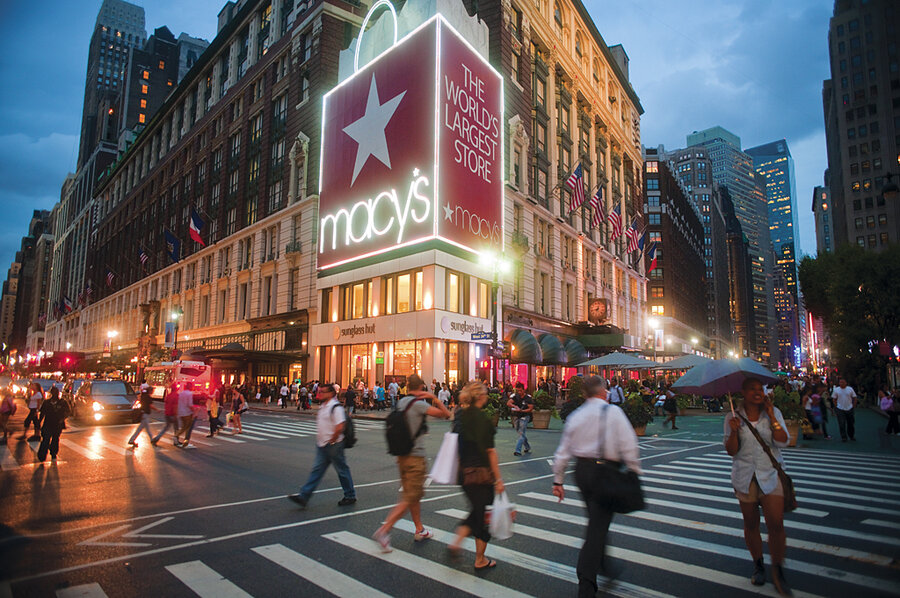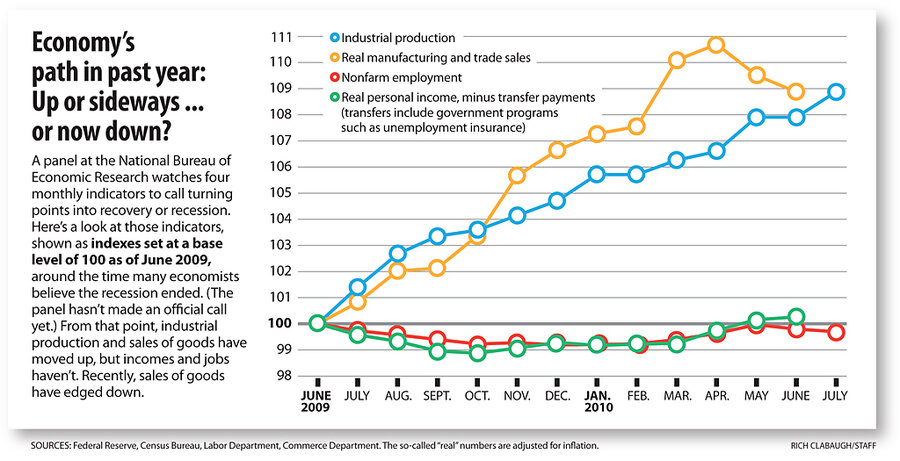The barely discernable economic recovery: What happened?
Loading...
Signs of economic recovery, which looked promising early this year, have seemed to wilt as the sun grew hotter.
The economy didn't go off a cliff, but the upward momentum stalled. Some important indicators, such as retail sales, registered outright declines.
This slowdown caught forecasters partly by surprise and has prompted new worries about the risk of another recession. For investors, a recent move by the Federal Reserve toward a more cautious policy stance did more to confirm fears than to assuage them.
Why did the stall happen, and what does it portend?
Many factors played a role, from a crisis in Europe to the end of a tax credit for home buyers. Most forecasters continue to see slow growth ahead, but they say a "double dip" into recession is possible – and is more likely now than during a typical early-stage recovery.
"One of the biggest things that is facing us as a country is just consumer confidence. I think that's what's keeping people from buying homes right now," says Paul Latture, president of the Rutherford County Chamber of Commerce in Murfreesboro, Tenn. "Just about everybody has felt a slowdown in the economy."
Knowing what will come next is difficult for two reasons. First, economists often fail to accurately predict turning points (they generally missed the onset of recession at the end of 2007, for example). Second, as the moniker "Great Recession" implies, this downturn has been a different animal. For the first time in at least 60 years, the US economy is trying to shift back into growth mode even as the flow of credit has been diminishing.
"Odds of a near-term double-dip recession, which appeared to be about 1 in 5 this spring, are now greater than 1 in 4," economist Mark Zandi of Moody's Economy.com wrote in an Aug. 16 report. "The recovery remains tentative, and nothing else must go wrong."
The consensus view of economists surveyed recently by the Federal Reserve Bank of Philadelphia is that there's a 17 percent chance that America's overall gross domestic product (GDP) will contract in the final quarter of this year and the first quarter of 2011. Still, during the next five quarters, their base-line forecast is for GDP growth ranging from 2.3 to 3.1 percent.
All this is a step down from the pace of growth seen earlier this year when first-quarter growth rolled along at a 3.7 percent annualized pace. In the second quarter, growth came in at 2.4 percent, according to an advance estimate. And the job market cooled noticeably.
Here's what changed:
Global economy. A debt crisis in Europe temporarily roiled credit markets in America. Meanwhile, imports to the United States posted an unusually strong rise, which counts as a negative for GDP.
Government stimulus. Money from the 2009 Recovery Act is still flowing, but the impact on GDP is fading. Meanwhile, measures such as a tax credit for first-time home buyers have run out, and states continue to cut spending.
On balance, fiscal policy is shifting from stimulative to contractive (probably reducing GDP growth by about one percentage point in the year's second half), according to economists at Goldman Sachs.
Consumer behavior. Households are spending, but cautiously. Many have seen job losses, pay cuts, or declines in the value of homes or retirement accounts. An uptick in personal savings is probably good news for family finances in the long run, but it holds back consumer demand.
Business behavior. Employers are reluctant to hire without clearer signs of a consumer rebound. They also cite uncertainties surrounding federal policy – everything from how health-care reform will affect the cost of labor to whether some taxes will rise next year.
Inventories. Manufacturing activity has revived over the past year, in part because companies needed to rebuild their inventories from recession-panicked low points. Now, some economists say, this restocking may be in the process of slowing down.
What's needed to get the US economy moving faster? That could be the pivotal question of the congressional election season.
Economists and business leaders point to a few areas where policies can make a difference: credit conditions, incentives for hiring, and overall government policy. But they differ on the precise approaches that might help most.
A vital step, say many business people, is a change in tone from government, following a period of both emergency interventions in the economy and major health-care reform legislation.
"Things that all levels of government can do to be pro-business will certainly be a big help," says Mr. Latture in Murfreesboro. "Having some predictability as to what's going to happen is key."
His county has seen some positive signs – for example, the expansion of a factory where Nissan will make its Leaf electric car. But the unemployment rate there remains near the national average of 9.5 percent.
While some policy experts argue for more federal stimulus spending or tax cuts, voters are skeptical of measures that would add to the soaring federal debt. One possible tack is to have any new stimulus be offset by other fiscal changes. Such efforts could include an extended payroll-tax holiday for employers, designed to boost hiring.
"A payroll tax is a direct tax on employment," says Paul Kasriel, director of economic research at the Northern Trust Co. in Chicago.
On the question of credit, he says, lending conditions have gone from overly easy before the financial crisis to overly tight.
The Federal Reserve could consider new efforts to encourage lending. With or without more Fed help, an expansion of credit is the vital underpinning to Mr. Kasriel's forecast that the economy will grow – at a tepid 2.6 percent pace – next year.






